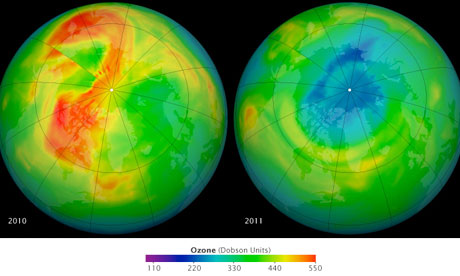Advertisement
If you have a new account but are having problems posting or verifying your account, please email us on hello@boards.ie for help. Thanks :)
Hello all! Please ensure that you are posting a new thread or question in the appropriate forum. The Feedback forum is overwhelmed with questions that are having to be moved elsewhere. If you need help to verify your account contact hello@boards.ie
massive hole in ozone layer,biggest so far......
Options
-
03-10-2011 11:52pm#1

October 3, 2011 – ARCTIC - A huge hole that appeared in the Earth’s protective ozone layer above the Arctic in 2011 was the largest recorded in the northern hemisphere, though the sudden appearance of the hole was not due to man-made causes, scientists said in a report on Monday. The ozone layer high in the stratosphere acts like a giant shield against the sun’s ultraviolet (UV) radiation, which can cause skin cancer and cataracts. Since the 1980s, scientists have charted the size of the ozone hole every summer above the Antarctic. Some years, the holes have been so large that they covered the entire continent and stretched to parts of South America. During extreme events, up to 70% of the ozone layer can be destroyed, before it recovers months later. The hole above the Arctic was always much smaller – until March this year, when a combination of powerful wind patterns and intense cold temperatures high up in the atmosphere created the right conditions for already-present, ozone-eating chlorine chemicals to damage the layer. The findings, reported on Monday in the journal Nature, show that the hole had opened over northern Russia, parts of Greenland, and Norway, meaning people in these areas were likely to have been exposed to high levels of UV radiation. “The chemical ozone destruction over the Arctic in early 2011 was, for the first time in the observational record, comparable to that in the Antarctic ozone hole,” say the scientists, led by Gloria Manney of the Jet Propulsion Laboratory in Pasadena, California. The scientists say man-made chemicals such as chlorofluorocarbons (CFCs) destroy ozone in the stratosphere, after sunlight breaks up the complex chemicals into simpler forms that react with ozone. While some of the chemicals are covered by a UN treaty that aims to stop their use, it will be decades before they are fully phased out of production. Normally, atmospheric conditions high above the Arctic do not trigger a large-scale plunge in ozone levels. But during the 2010/11 winter, a high-altitude wind pattern called the polar vortex was unusually strong, leading to very cold conditions in the stratosphere that also lasted for several months. This created the right conditions for the ozone-destroying forms of chlorine to slash ozone levels over a long period. The report’s authors said there was a risk that the spread of the Arctic hole could become an annual event. –The Guardian
Environment
Ozone layer
Hole in Antarctic ozone now three times size of US
reddit this Tim Radford, Science editor The Guardian, Saturday 9 September 2000 00.49 BST Article historyThe hole in the ozone layer over Antarctica is bigger than ever, US scientists announced yesterday. Nasa has measured the area of thinning ozone as covering an area three times the size of the US.
Ozone in the stratosphere forms a natural shield to filter harmful ultraviolet light. But for more than 15 years there has been alarm at dramatic thinning over Antarctica and more recently the Arctic.
A worldwide agreement reached more than 10 years ago banned the long-lived chemicals responsible for ozone destruction. But because of their longevity they are expected to go on damaging the ozone layer for decades. The polar regions are particularly at risk because the chemical reaction which destroys ozone is helped by their weather conditions.
The holes appear each spring - in March in the north and September in the south. Nasa reports that the hole over Antarctica had reached a record size of about 11m square miles by September 3.
Scientists say the hole has stopped growing this year in area but the levels of ozone within are continuing to fall. The lowest readings are usually at the end of September or early October.
Lower levels of ozone are linked to increases in skin cancer and cataracts. There is also fear that ultraviolet radiation could harm plants and microbes. Ozone is an unstable form of oxygen actually created by ultraviolet light. It breaks down and forms again but the presence of chlorine-based CFC chemicals from, among other things, old-style aerosols is interfering with the process.
"These observations reinforce concerns about the frailty of earth's ozone layer. Although production of ozone-destroying gases has been curtailed under international agreements, concentrations of the gases in the stratosphere are only now reaching their peak. Due to their long persistence in the atmosphere, it will be many decades before the ozone hole is no longer an annual occurrence," said Michael Kurylo, manager of the upper atmosphere research programme at Nasa.
Most atmospheric ozone is found between six miles and 18 miles above the earth's surface.
Scientists continuing to investigate this enormous hole are somewhat surprised by its size. "Variations in the size of the ozone hole and of ozone depletion accompanying it from one year to the next are not unexpected," said Jack Kaye at Nasa. "At this point we can only wait to see how the ozone hole will evolve in the coming few months."
Although Nasa satellites began searching for signs of ozone destruction 20 years ago, the hole was discovered by British scientists taking balloon measurements in the Antarctic in 1985.
Brian Gardiner, one of the three British discoverers of the ozone hole, said yesterday: "It is the start of the springtime depletion. We are watching it and the bottom line is it is not getting any better."4
Advertisement